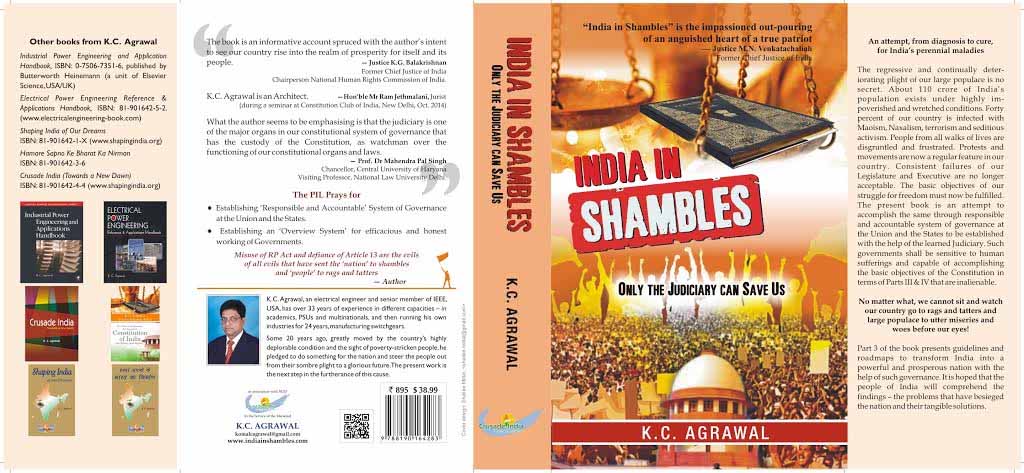Book at a Glance
PART I - Electric Motors, Drives and Energy Saving
Chapter 6. Static Drives and Energy Saving
• Speed control in squirrel cage motors
• Speed control through solid-state technology
• V/f control (speed control at constant torque)
• Phasor (vector) control
• Use of phasor control for flux braking
• Control and feedback devices
• Evolution of solid-state technology
• Conduction and commutation
• Circuit configurations of semiconductor devices
• Smoothing of ripples in the d.c. link
• Providing a constant d.c. voltage source
• Providing a constant current source
• Generation of harmonics, over-voltages and voltage surges in a static device switching circuit and to mitigate their effects
• PWM inverter drives causing shaft currents
• Energy conservation using static drives
• Application of static controllers
• Speed variation through variable-speed fluid couplings
• Static drive versus fluid coupling
• D.C. drives S Retrofitting of EE motors and drives
PWM inverter drives causing shaft currents
When a motor is driven through a PWM inverter unit, a peculiar phenomenon of bearing currents and their failure as a consequence of it is noticed in certain range of motors. Typically for frame sizes .315 and inverter switching frequency fs >10 kHz. The situation becoming worse at higher frequencies (IEC 60034-17 and ref. 11 under Further Reading).
The windings leakage capacitances (Figure 10.6(a)) at high pulses of the inverter output voltage offer a very low reactance (Xc å1/fs) and may discharge even at low stator voltages. The effect of high frequency now is similar to, rather worse than that of high voltages in MV motors noted in Section 10.4.5 and induces shaft voltages as a result of capacitive coupling. in fact the very high frequencies cause much higher shaft voltages and consequent much larger leakage currents than in MV motors. These shaft voltages are noticed up to 10–30 V (for frame sizes above 315). At high frequencies (>10 kHz) the grease dielectric may break down at about 10–15 V and allow the leakage current flow through the bearings. As a result bearings emanate sort of a scratching noise. These currents if not prevented are dangerous and may cause bearings’ failure. Prevention from shaft currents in PWM inverter drives is similar to as discussed in Section 10.4.5.
Energy conservation using static drives
• Speed control through solid-state technology
• V/f control (speed control at constant torque)
• Phasor (vector) control
• Use of phasor control for flux braking
• Control and feedback devices
• Evolution of solid-state technology
• Conduction and commutation
• Circuit configurations of semiconductor devices
• Smoothing of ripples in the d.c. link
• Providing a constant d.c. voltage source
• Providing a constant current source
• Generation of harmonics, over-voltages and voltage surges in a static device switching circuit and to mitigate their effects
• PWM inverter drives causing shaft currents
• Energy conservation using static drives
• Application of static controllers
• Speed variation through variable-speed fluid couplings
• Static drive versus fluid coupling
• D.C. drives S Retrofitting of EE motors and drives
PWM inverter drives causing shaft currents
When a motor is driven through a PWM inverter unit, a peculiar phenomenon of bearing currents and their failure as a consequence of it is noticed in certain range of motors. Typically for frame sizes .315 and inverter switching frequency fs >10 kHz. The situation becoming worse at higher frequencies (IEC 60034-17 and ref. 11 under Further Reading).
The windings leakage capacitances (Figure 10.6(a)) at high pulses of the inverter output voltage offer a very low reactance (Xc å1/fs) and may discharge even at low stator voltages. The effect of high frequency now is similar to, rather worse than that of high voltages in MV motors noted in Section 10.4.5 and induces shaft voltages as a result of capacitive coupling. in fact the very high frequencies cause much higher shaft voltages and consequent much larger leakage currents than in MV motors. These shaft voltages are noticed up to 10–30 V (for frame sizes above 315). At high frequencies (>10 kHz) the grease dielectric may break down at about 10–15 V and allow the leakage current flow through the bearings. As a result bearings emanate sort of a scratching noise. These currents if not prevented are dangerous and may cause bearings’ failure. Prevention from shaft currents in PWM inverter drives is similar to as discussed in Section 10.4.5.
Energy conservation using static drives


